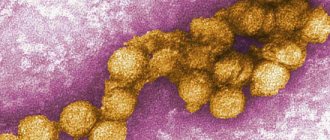Vaccination against pneumococcal infection has become mandatory in Russia since 2014. The purpose of the vaccine is to prevent diseases caused by the pneumococcal bacterium. Protection against disease is guaranteed when completed on time.
Pneumococcus is a type of bacteria from the genus Streptococcus. The bacterium can most often cause the following diseases:
- pneumonia;
- meningitis;
- endocarditis;
- bacterial rhinosinusitis;
- a number of other dangerous infections: conjunctivitis, phlegmon, peritonitis, sepsis.
Some diseases caused by the pneumococcus bacterium can lead to death (eg, meningitis, sepsis).
Pneumococcus lives in the respiratory organs of adults and children. The infection most often occurs between the ages of 6 months and two years. Children under this age have maternal antibodies that prevent the development of the disease.
Indications
More than ninety types of infections that cause disease are known. The peculiarity of this bacterium is its shell, which acts as a pathogenicity factor. It prevents you from developing immunity to the disease. Therefore, children get sick many times. Even if the baby does not attend kindergarten, the first and subsequent vaccinations should be done as early as possible. Bacterial infection occurs quickly. In childhood, this vaccine is considered mandatory. Also, in old age, vaccination is mandatory. After 60 years, diseases become chronic. The penetration of a dangerous infection can lead to complications in vital organs in case of illness. Therefore, old people in nursing homes and children in orphanages also need to be vaccinated.
According to the Internal Service Charter, army personnel are required to be vaccinated. Before entering the army, conscripts are given a vaccine against pneumococcal infection (during the autumn conscription period). During conscription, soldiers are also vaccinated against rubella, tick-borne encephalitis, and hepatitis.
What is pneumonia and how does it occur?
Pneumonia is an acute infectious disease (inflammation) of the lung tissue, which is caused by viruses, bacteria, fungi and parasites. As a rule, viral pneumonia is the most difficult to diagnose due to rapid microbial infection.
“The root cause of viral pneumonia is usually viruses that infect the mucous membrane of the respiratory tract, disrupt the barrier function of the epithelium, reduce local immunological defense and facilitate the penetration of pathogens into the lower parts of the respiratory system. There, intensive proliferation of microorganisms occurs and inflammation develops, which involves adjacent areas of the lung tissue,” says Madina Abdulaeva.
Contraindications
Any vaccination is additional work for immunity. It may be contraindicated in the following cases:
- If the child is under two months old, vaccination is contraindicated. 8 weeks is the optimal age for immunization;
- during exacerbation of any disease;
- intolerance to vaccine components;
- in the first and second trimesters of pregnancy;
- with fever.
The decision to shift the schedule is made by the doctor together with the patient. In some cases it is worth waiting for remission, in others - not at all.
Release form
Suspension for intramuscular administration, 0.5 ml/dose. 0.5 ml per 1 ml syringe made of transparent, colorless glass (type I).
1 syringe and 1 sterile needle in a plastic package sealed with plastic film. 1 plastic package together with instructions for use is placed in a cardboard box with or without first opening control. 5 syringes are placed in a plastic package sealed with plastic film. 2 plastic packages and 10 sterile needles along with instructions for use are placed in a cardboard box with or without tampering.
The effectiveness of immunoprophylaxis
Research by the Department of Infectious Diseases of the Northern State Medical University has proven the effectiveness of the vaccine against severe forms of pneumococcal infection. Practice has shown that, compared with unvaccinated children, the incidence of severe forms of the disease among vaccinated children is:
- meningitis, sepsis – 80% less;
- otitis, pneumonia - 30% less.
According to WHO, mass immunoprophylaxis reduces the incidence of meningitis and otitis in children, and there are fewer carriers of pneumococci. In addition, the disease is becoming less and less common among unvaccinated adults and children.
The health organization predicts that worldwide use of the pneumococcal vaccine will help prevent the deaths of 5.4-7.7 million children by 2030.
The effect of pneumococcal vaccines was refuted in the media, and cases of death from vaccinations were cited. However, the media rarely provides statistics on the death of children who could not withstand the infectious pressure, although such data exist.
Pharmacological (immunobiological) properties
Administration of the Prevenar® 13 vaccine causes the production of antibodies to capsular polysaccharides of Streptococcus pneumoniae, thereby providing specific protection against infections caused by 1, 3, 4, 5, 6A, 6B, 7F, 9V, 14, 18C, 19A, 19F and included in the vaccine 23F pneumococcal serotypes.
According to WHO recommendations, for new conjugate pneumococcal vaccines, the equivalence of the immune response of the Prevenar® 13 vaccine was determined according to three criteria: the percentage of patients who achieved a concentration of specific IgG antibodies ≥0.35 μg/ml; geometric mean concentrations (GMC) of immunoglobulins and opsonophagocytic activity (OPA) of bactericidal antibodies (GPA titer ≥1:8 and geometric mean titers (GMT). For adults, the protective level of anti-pneumococcal antibodies has not been determined and a serotype-specific GMT is used.
The Prevenar® 13 vaccine includes up to 90% of the serotypes that cause invasive pneumococcal infections (IPI), incl. resistant to antibiotic treatment.
Types of vaccines
There are 3 types of vaccines in our country. The actual classification depends on the number of strains in the injection:
- "Prevenar" (USA). There are 2 types: the number in the name 7 or 13 indicates the number of virus strains in the composition. Used in many countries around the world. Children from five months to 2 years can be vaccinated.
- "Synflorix" (Belgium). Against 10 strains of the virus. Also contains an ingredient against hemophilus influenzae. The vaccine was recently registered in the country, the benefits have not yet been thoroughly studied (except for the low price).
- "Pneumo 23" (France). The vaccine is the “oldest” in the world. Can be done from 2 years old. Protects against 23 strains. The effect of the drug is justified by long-term use. It is painful to tolerate and adverse reactions may occur.
Vaccination dates
A necessary rule for vaccination is to observe the interval between vaccinations.
Vaccination scheme against pneumococcal infection
| Age for first injection | Dose | Scheme of implementation |
| 2-6 months | 3 | 3 doses every month each. Revaccination should be carried out at 1 year and 3 months |
| 7-11 months | 2 doses | The interval is a month. Re-inserted after first birthday |
| 12-23 months | 2 doses | Minimum interval 2 months. Repeatedly according to indications |
| 2-5 years | 1 dose | One time |
This vaccination calendar is a system for the rational use of vaccines. It will be useful for parents to contact him to determine the right moment for vaccination.
Compound
| Suspension for intramuscular administration | 1 dose (0.5 ml) |
| active substances: | |
| pneumococcal conjugates (polysaccharide - CRM197): | |
| polysaccharide serotype 1 | 2.2 mcg |
| polysaccharide serotype 3 | 2.2 mcg |
| polysaccharide serotype 4 | 2.2 mcg |
| polysaccharide serotype 5 | 2.2 mcg |
| polysaccharide serotype 6A | 2.2 mcg |
| polysaccharide serotype 6B | 4.4 mcg |
| polysaccharide serotype 7F | 2.2 mcg |
| polysaccharide serotype 9V | 2.2 mcg |
| polysaccharide serotype 14 | 2.2 mcg |
| oligosaccharide serotype 18C | 2.2 mcg |
| polysaccharide serotype 19A | 2.2 mcg |
| polysaccharide serotype 19F | 2.2 mcg |
| polysaccharide serotype 23F | 2.2 mcg |
| carrier protein CRM197 | »32 mcg |
| excipients: aluminum phosphate - 0.5 mg (in terms of aluminum - 0.125 mg); sodium chloride - 4.25 mg; succinic acid - 0.295 mg; polysorbate 80 - 0.1 mg; water for injection - up to 0.5 ml |
Features of childhood vaccination
Parents need to know how to prepare for vaccination:
- the child is not introduced to new complementary foods 3 days before/after the injection. If the baby is breastfeeding, the mother can wait a while with new products, especially allergenic ones;
- A healthy child should not have any complications, but it is better to play it safe and get tested to make sure he is in complete health;
- Doctors recommend refraining from walking and swimming on the day of vaccination. This is necessary in order to exclude hypothermia or the possibility of contracting any other infection.
According to the instructions, the rules for administering the vaccine require an intramuscular injection. If the child is under two years old, they place it in the thigh, the anterolateral muscle, or perhaps in the shoulder.
It is prohibited to mix different vaccines in one syringe.
At the appointment before administering the vaccine, the doctor examines the child and measures body temperature. If there are skin rashes, vaccination is postponed until recovery.
Interaction
There are no data on the interchangeability of Prevenar® 13 with other pneumococcal conjugate vaccines. When immunized simultaneously with Prevenar® 13 and other vaccines, injections are made into different parts of the body.
Children 2 months - 5 years
Prevenar® 13 is combined with any other vaccines included in the immunization schedule for children in the first years of life, with the exception of BCG. Simultaneous administration of the Prevenar® 13 vaccine with any of the following antigens included in both monovalent and combination vaccines - diphtheria, tetanus, acellular or whole-cell pertussis, Haemophilus influenzae (type b), polio, hepatitis A, hepatitis B, measles, mumps , rubella, chickenpox and rotavirus infection - does not affect the immunogenicity of these vaccines. Due to the higher risk of developing febrile reactions in children with seizure disorders, incl. with a history of febrile convulsions, and also receiving Prevenar® 13 vaccine simultaneously with whole-cell pertussis vaccines, symptomatic administration of antipyretics is recommended. When the Prevenar® 13 and Infanrix-hexa vaccines were used together, the frequency of febrile reactions coincided with that for the combined use of the Prevenar® (PCV7) and Infanrix-hexa vaccines. An increased incidence of reported seizures (with and without fever) and hypotensive-hyporesponsive episodes was observed with the combined use of Prevenar® 13 and Infanrix-hexa vaccines. Antipyretic medications should be initiated in accordance with local treatment guidelines for children with seizure disorders or a history of febrile seizures and in all children receiving Prevenar 13 concomitantly with vaccines containing whole cell pertussis.
Prevenar® 13 can be used together with meningococcal polysaccharide vaccine serotypes A, C, W and Y, conjugated to tetanus toxoid, in children aged 12–23 months. Post-marketing data from a post-marketing study of prophylactic antipyretics on the immune response to Prevenar® 13 vaccine suggest that prophylactic administration of acetaminophen (paracetamol) may reduce the immune response to the primary vaccination series with Prevenar® 13 vaccine. Immune response to booster vaccination with Prevenar® 13 vaccine in 12 months with prophylactic use of paracetamol does not change. The clinical significance of these data is unknown.
Children and adolescents 6–17 years old
There are no data on the use of Prevenar® 13 simultaneously with the vaccine against human papillomavirus infection, meningococcal conjugate vaccine, tetanus, diphtheria and pertussis vaccine, and tick-borne encephalitis.
Persons 18–49 years old
There are no data on the simultaneous use of Prevenar 13 with other vaccines.
Persons 50 years and older
Prevenar® 13 can be used in conjunction with trivalent or quadrivalent inactivated seasonal influenza vaccine (DVT or IV). When Prevenar® 13 and DVT were used in combination, immune responses to DVT were similar to those obtained with DVT alone, and immune responses to Prevenar 13 were lower than with Prevenar 13 alone. The clinical significance of this finding is unknown. The incidence of local reactions did not increase with simultaneous administration of the Prevenar® 13 vaccine with inactivated influenza vaccine, while the incidence of general reactions (headache, chills, rash, loss of appetite, joint and muscle pain) increased with simultaneous immunization. Concomitant use with other vaccines has not been studied.
Prevenar vaccination: why is it done?
One of the most popular vaccines against pneumonia is Prevenar 13. It has been well researched and has won the highest ratings from experts, which gives confidence in its absolute safety even for the youngest children. Vaccination with Prevenar is carried out from an early age so that the baby develops protective antibodies to 13 serotypes of pneumococcus, since, as mentioned above, children are especially susceptible to pneumococcal infection.
pixabay.com/
How dangerous is pneumonia in children and what are its health consequences?
The main complications of pneumonia are pleurisy, pulmonary destruction (lung tissue abscesses, bullae, pneumothorax, pyopneumothorax), pleural empyema, pulmonary edema and pulmonary heart failure. The most dangerous consequence of the disease is infectious-toxic (bacterial) shock.
If we talk about the consequences of pneumonia for a child’s health, then in the future he may experience repeated respiratory tract infections with a long recovery period and a decrease in local immunity of the respiratory tract mucosa. Children who have had pneumonia are at risk for developing bronchial asthma, pulmonary tuberculosis, and chronic bronchopulmonary diseases.
pixabay.com/Semevent
What pneumonia are they vaccinated against?
The most common pathogen in the development of pneumonia (70-80% of all pneumonia) is pneumococcus. Pneumococci also provoke very severe meningitis, sepsis, less often arthritis, osteomyelitis and myocarditis, acute otitis media.
“Pneumonia can also be caused by other bacteria and viruses. But pneumococcal pneumonia is still the most common, and it is becoming less and less treatable due to the increase in antibiotic resistance of pneumococci - that is, their insensitivity to antibiotics,” explains the expert.
Vaccination with pneumococcal vaccines can only protect a child from pneumonia that is caused by those serotypes of pneumococcus that are included in a specific vaccine, and cannot protect against pneumonia caused by other bacteria and viruses. Therefore, when vaccinating a child, we set the goal of protecting him not from everyone, but from the most severe pneumonias, which are often difficult to treat, and this, you see, is no less important.






